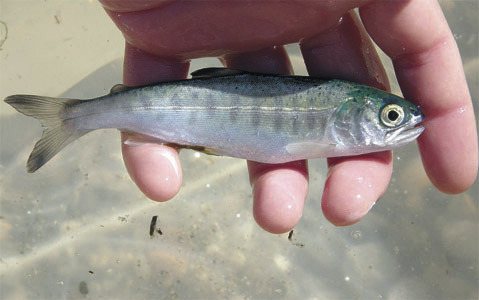By Madrona Murphy
Kwiaht’s Botanist and genetic technician
Every summer, hundreds of thousands of juvenile chinook salmon visit San Juan County on their way to the ocean, feasting on the islands’ herring, sand lance, larval crabs and insects.
Why do some of these fish remain in the islands and become blackmouth salmon, a critical resource for recreational anglers?
Although it is Washington state policy to use hatcheries to increase the supply of blackmouth for anglers, and most of the blackmouth caught today began life in a hatchery, there is no simple genetic basis for this lifestyle choice by individual salmon. Some clues have been discovered by a long-term salmon food-web study by the Lopez-based conservation laboratory Kwiáht, which just issued a report summarizing five years of research sampling over two thousand juvenile chinook in the islands’ nearshore waters.
On the whole, says Director Russel Barsh, juvenile chinook prefer to eat oily herring or sand lance, but about one in six juvenile chinook prefers insects and other invertebrates even when baitfish are plentiful. Both wild and hatchery chinook exhibit this behavior.
Biologists call this a “portfolio strategy” and believe that it makes efficient use of all available resources. The Kwiáht team has discovered that juvenile chinook leave the islands quickly after a few calorie-rich meals of herring or sand lance, but stay in the islands for weeks or months if they are eating crustaceans or insects.
“Fishy years should produce very few blackmouth,” Barsh says, “but there will always be at least some blackmouth because of individual food preferences at this stage in chinook life histories.”
Barsh adds that there is some evidence for a genetic basis for food preferences in salmon, but preferences may also be learned. Kwiáht scientists need the help of local anglers to learn more about the biology of the islands’ blackmouth.
If you catch and keep a blackmouth this winter, set aside a tail fin clipping the size of a dime and freeze it in a plastic sandwich bag. If possible save the gut contents as well in a separate plastic bag, place it inside the bag with the fin clip, and freeze them all together. Frozen fin clips and gut contents can be dropped off at the Indian Island Marine Health Observatory office in Eastsound (in the Post building) and the Kwiaht office on Lopez (#9 Lopez Plaza).
The DNA in the fin clip can be compared with DNA from the thousands of fish already sampled as juveniles by Kwiáht scientists and volunteers, and the gut contents of course will identify the resources that blackmouth rely on as adults. The blackmouth study is co-sponsored by the Wild Fish Conservancy and Long Live the Kings.
For further information contact: kwiaht@gmail.com.



